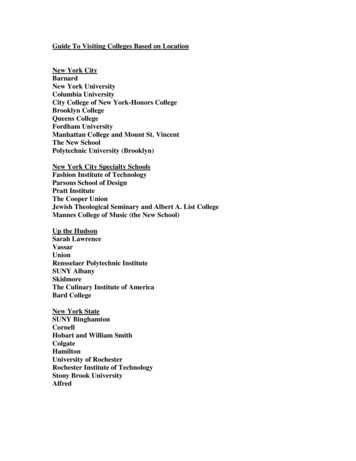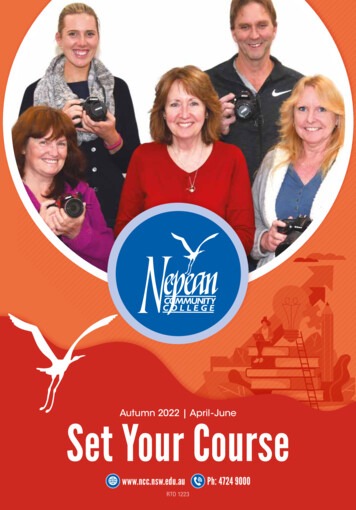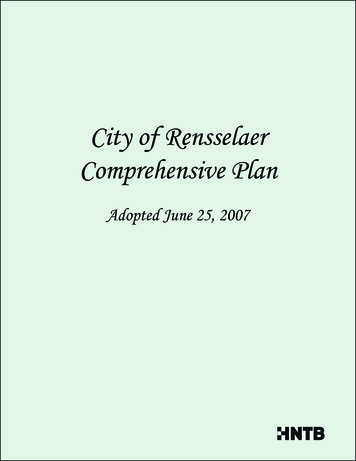
Transcription
BeginnersGuideBy, Mr T.O. Holt
KendoKendo is the art of Japanese sword fighting that was practiced by the Samurai. The art ofcombat was a very important part of their lives, so they trained their sword skills every day.Kendo literally translated “Ken” sword and “Do” the way, together it means, “The Way of theSword”. In the past the Samurai practiced using real swords or wooden ones in prearrangedforms called Kata. Consequently injuries were high. These difficulties were overcome by thewearing of protective pads on the head and forearms. These pads were gradually altered andmodified over many years to the armour that is worn today by people that practice Kendo.The wooden sword used for practice also went through many changes. The sword usedtoday is called a Shinai and is made of four pieces of bamboo carefully shaped whichsubstitutes the real sword and allows true and accurate strikes to be made. Although thesword and armour of the Samurai have changed, the spirit and fighting techniques haveremained virtually the same. While the Samurai's life depended upon his skill and speedwith the sword, the present day's form of Kendo is a sport and International & Nationalcompetitions are held where speed and skills with the Shinai are required. As with theSamurai, true and accurate strikes have to be made to those parts of the opponent's bodywhich would quickly incapacitate them. The target areas of the body are protected by apadded mask, with a metal grill to protect the face and head, called a “MEN”, a heavy breastplate of bamboo splints and rawhide to protect the trunk of the body “DO”, and paddedgauntlets for the hands and wrists “KOTE”, as well as a padded thigh protector “TARE”. Thisequipment permits realistic full contact fencing matches that follow the rules and principalsof traditional Japanese swordsmanship. Students of kendo (kendoka) come from all walksof life and of all ages, women train on equal terms with men. Kendo can be safely practisedby men, women and children of all ages, and the type and the level of practice may ofcourse be adjusted to suit everyone.ShinaiMenKoteDO CLUKEN DONLONKENDO CLUBLONDONDoTare1B
The DojoThe hall used for Kendo is known as theDojo. The word Dojo has its origin in Buddhismand means place where ascetic training in theprinciples of Buddhism took place. Accordingly,this area, was highly respected as a holy andspiritual training place. Today a dojo is a place inwhich the martial arts are taught and practised.However strong links still exist binding today'sdojo to their predecessors. There are manydifferent dojo layouts, one feature often found insome dojo is the Kamidana , a miniature shrine to the patron saint of the dojo. Some dojohave a banner or writing describing the dojo name or policy. The place reserved for senseior respected guests is called the “Kamiza” or “Joseki” (high seat).The traditions of Kendo require a strict observance of etiquette within the dojo by all. Kendostarts with courtesy and finishes with courtesy. When compared with other sports it would beeasy for Kendo to degenerate into wild and uncontrolled aggression. By keeping to strictcodes of behaviour, students of Kendo keep the conflicting emotions generated by Kendounder control.Etiquette in the DojoTry not to arrive late at the dojo . Be at the dojo in plenty of time to change and warm up etc.Remove shoes before entering the dojo, never walk to the dojo in bare feetWhen entering or leaving the dojo, make a correct standing bow (rei) to the dojo honouringthe place of practice.Carry your equipment and other bags into the dojo in a most respectful way and place themon the floor in a safe and correct way.Make sure the dojo floor is cleaned and safe before starting practice.When in the dojo the armour should only be put on or adjusted from seiza position(Kneeling down).The sensei's of the dojo should be treated correctly and with respect at all times.The sensei sits on the high side of the dojo which is called the “kamiza” (joseki), the seniorsensei sits furthest away from the door. All the others sit opposite the sensei; often thesenior grades are first in line with lower grades down the line but other factors such as agecan be taken into account.Try not to walk in front of other kendoka sitting on the dojo floor. If this is unavoidable, bowslightly and extend your right hand in front of you as you pass.Do not step over a shinai or bokuto, but walk around it.2
Do not move another player’s armour unless asked to or permission is given by theowner.Bow to your opponent at the start and finish of each practice.During practice higher grades stand on the sensei side of the Dojo, facing the lowergrades.If shinais or armour need to be adjusted during practice, you should indicate to yourpartner by rising your right hand and then, both in standing position put your shinaisaway (Osame-to) step back out of the way of others. You should sit in seiza andmake the necessary adjustments. The opponent waits until the adjustment is made,then both bow and recommence practice.If you have to leave the dojo during training for any reason please ask permissionfrom the dojo senior member (Senpai) or the sensei. It is good manners to let usknow also if you are not feeling well, you might need help .During Kendo practice, there should be no talking between players. The trainingsession is a time of learning and not a time for discussion or gossip, there is timeenough for this afterwards.Respect at all times should be shown to the sensei, dojo and fellow students.Personal thanks are expressed with a kneeling rei between sensei and students,and amongst fellow students.The final rei marks the end of the training session and students are free to leave thedojo. However bogu should be properly packed away before leaving the dojo.If relaxed sitting is permitted sit with legs crossed and back straight. Ensure feet arecovered by hakama. This is the only other acceptable sitting position in the dojoother than seiza. Do not allow yourself to slump.Seiza (Formal sitting kneeling)Seiza is the formal Japanese style of sitting (kneeling). Kneel with your knees about20 cm apart, your feet should be slightly crossed, with the big toe of the right footresting on top of the left. Your hands should rest lightly on your thighs with fingersextended and together. The back should be straight, with shoulders relaxed andhead looking directly forward with the mouth closed. The correct way to assumeseiza from a standing position is to lower your weight onto your left knee first, andthen your right. Once you have assumed seiza it is important that you carefullyadjust your position, so you are initially comfortable (this may take some practice) asit is important, that once you are sitting in seiza you do not adjust your position.The first reason for this is that it is impolite, from an etiquette point of view, to movearound whilst a senior person is speaking to you. The second is that whilst seiza isuncomfortable because it restricts the flow of blood to the lower legs. The practice ofrocking the body weight from one leg to the other, whilst being rude, causes anunnaturally high blood pressure in the lower legs, as it traps more blood in the lowerleg than would normally be there, which can cause nerve and blood vessel damage.When rising to a standing position, the reverse process is used, place the right footon the floor first and stand up. Your hands should not touch the floor either inkneeling or rising from seiza, and the back should remain straight at all times.3
Seiza(formal sitting)Diagram shows how to sit down and stand up and how to place your shinai, kote andmen in front of youMokuso (Meditation)From seiza, lightly close your eyes and rest both hands palmup in your lap. Place the fingers of either the left hand or thefingers of the right hand on top. The thumbs should touch lightlytogether. Quietly start breathing, slowly from the abdomen.Now open your mind to the kendo practice and away from anyother thoughts4KENDO CLUBLONDON
Rei (The bow) Zarei (Kneeling bow):Keeping your eyes on your opponent and withoutraising your hips or bending your neck, lean your bodyforward. Advance your hands slightly in front of your knees,placing both of them on the floor with finger tips justtouching slowly lowering your head. Hold this position for abrief moment, then reverse the process to return to youroriginal position. Be careful not to stick your elbows out likewings, and not to let your head touch the floor.Ritsurei (Standing bow)Keep eye contact with your opponent and without bending your neck or knees, bendyour upper body forward, at the hips, to an angle of about 15 to your opponent and30 to Kamiza (Joseki) looking at the floor. Keep your arms at the side of your bodynot letting them swing forward in front of you. Make sure the tip of your shinai doesnot raise up, keep it pointing down. Hold this position for a short period and returnto a normal standing position.15 30 5
HOW TO WEAR AND FOLD YOUR HAKAMA AND KEIKOGIIt is often said that Kendo starts the moment you set foot within the Dojo. This is not howeverentirely true, as before you enter the Dojo you must change into your Hakama and Keikogi,and this is the point at which you must also slip into your Kendo mind. From the first momentyou set foot in a Dojo, like it or not, you and your Kendo are being judged. So it is importantto create a strong and positive first impression by showing that if you know nothing else, youat least know enough to be able to dress yourself properly. This will mean that people will bemore willing to spend time with you on other areas of your Kendo. If however you enter theDojo poorly dressed, in a hakama or keikogi in bad condition or a hakama that has obviouslynot been folded properly, you will instantly create a bad impression, that will be very hard toovercome, no matter what standard of kendo you have. It is therefore important to learn howto wear your hakama and keikogi correctly and also to learn how to fold your hakama, so italways looks as good as the day you bought it. This will have a two fold effect, the first is thatyou will look good when you enter the Dojo. If you look good you will therefore feel goodabout what you are doing, things will become a little easier.Folding the hakamaA hakama appears deceptively difficult to look after, but is in fact quite easy to maintain if youspend five minutes after each time you wear it, by folding it. Washing is not a problem, justmake sure all the pleats are hanging in approximately the right place when you hang it out todry. Having dried your hakama you will want to fold your hakama properly, as there is nopoint in putting on a hakama if it hasn't been folded properly.A correctly folded hakama will never need ironing. First holding the front and the backtogether at the top, shake the hakama out so that the pleats are sitting in about the rightplace. Next make sure the inner middle pleat inside, is sitting to the right as shown in thediagram. Now lay the hakama flat on the ground with the back up, make sure the pleats inthe back of the hakama are sitting properly, working from the inside to the outside. Grasp thehakama at the top and bottom at the centre and holding it tight turn it over, being careful notto disturb the pleats in the back. Now make sure the pleats in the front are sitting properly,working from the middle to the edges. Once it is all lying smoothly, fold the sides of thehakama in to form a neat rectangle. Finish by folding the hakama into thirds to form a neatpackage, then following the diagram fold the himo (straps or ties) to complete the job.Remember you haven’t really finished playing Kendo until you have packed your equipmentaway properly.6
Now with a properly folded hakama andkeikogi you are ready to learn how to wearthem correctly. The first step in the processis to put on your keikogi, and here there islittle scope for error, so long as youremember that the left side of the keikogicrosses in front of the right, the himo(tie) on the breast should be tied in a neatreef knot that sits horizontally across thechest. Next grasping your hakama evenlyby the front , step into it, and lift it to a position just above your hips. To ensure that the frontof your keikogi sits flat hold the hakama slightly off centre, to the left, then holding thehakama against your stomach gently twist it into a central position. It is important that thefront of the hakama sits centrally on your body and is not twisted either to the left or right.Once you are satisfied that your hakama is properly positioned, slide your hands along thetapes and around your body to the middle of your back, being careful not to disturb the front.At this stage the tapes should form a horizontal line around your body and sit just above yourhips. Now cross the tapes over at the back and bring them around to the front so that theywill cross again at the front about 5 cm below the top of the hakama. Bring the tapes aroundto the back again, ensure that the tapes sit flat around your body, and tie them in bow orknot. At this stage it is a good a idea to make sure that your keikogi is sitting properly on yourback. Do this by grasping it below the tapes and gently pulling both sides down and towardsthe front, so that the cloth at the back of the keikogi sits flat against your back with no gathersor excess, also make sure the front of the keikogi is sitting neatly across your chest. Now pickup the back of your hakama. Some hakama have a small spoon shaped plastic tab attachedinside the back, slip this down between your back and the tapes, coming from the front of thehakama. If your hakama doesn’t have this tab ignore this step. Holding the back of thehakama slip the side tapes under the toptapes coming from the front of thehakama and pull them round to the frontfollowing the line of the lower set of tapes.Tie the tapes at the front in a reef knot insuch a way the knot holds together all thetapes at the front of the hakama, now takethe loose ends of the tapes and tuck themneatly under the other taps at the sides. Ifyou have a correctly fitting hakama, andyou have followed the instructions, yourhakama should hang so that it just clearsPlastic tabthe tops of your feet at the front and is slightly higher atthe back. Dressed properly you are now ready to enterthe Dojo. Of course there are many other importantthings you must remember on entering the Dojo that willhelp to make a good impression, each supporting theother. Dressing properly is important, but taking theopening idea to its logical conclusion, you will find thateverything you do outside the Dojo will have an effecton your Kendo, and in turn Kendo will have a positiveeffect on your life.7
Shinai care and maintenanceAs the shinai is one of the main pieces of equipment used in the practice of kendo and theone with the greatest potential to inflict serious injury in the event of a component failure, itis vital to carry out regular inspection and maintenance of your shinai. Whether you own atraditional bamboo shinai or one of hi-tech carbon graphite it is your duty to your fellowstudents to ensure that your equipment is in good condition. There is no excuse for causingan injury through the neglect of maintenance of your shinai. If deterioration of your shinai isdetected during training, stop immediately, excuse yourself and change to another shinai.Areas to checkSlats check for splinters, cracks, or break down of the bamboo itself. Repairs to minorsplinters can be made by sanding them out you can use WD40 or silicon spray or buy shinaisprays from Japan. These provide a good protection for the bamboo slats . Store yourshinais in a cool humid environment. Taping of worn or damaged slats is unacceptable.Carbon graphite, check for cracks, or areas where the carbon graphite core is exposed.There is no way to repair a damage carbon graphite slat. If there is any doubt as to thesafety of a carbon slat do not use it. Store carbon shinais in cool place away from direct sunlight as they are susceptible to UV radiation. For both types of slats, remember, ‘when indoubt throw it out”.1.Sakigawa: check the top for signs of wear and loose stitching, if the slats or thesakigomu can be seen through the sakigawa, replace it.2Sakigomu: check that the sakigomu is fitted in the end of the shinai correctly, and isnot damaged. This is particularly vital in the case of carbon graphite shinais, as adamaged or incorrectly fitted sakigomu in these can lead to premature and, dramaticdestruction .Good SakigawaBadSakigomu3Nakayui: check that it is tied tightly and in the right place at ¼ of the total length of theshinai, replace it when it breaks see below for how to tie up.4Tsuru: (Cord) ensure that it is tight enough to hold the sakigawa in place, but not sotight that it causes the shinai to bow. See bellow how to tie5Tsukagawa: (Handle) check for wear points on the leather handle and for breakdownof the seam. Replace if the seam is splitting or there are any holes in it.8
Ashi-Sabaki (Footwork)Kendo footwork is designed to allow freedom of movement yet at the same time allow animmediate response to any situation that may arise. Since the almost unlimited variety oftechniques require coordinated foot and shinai movement, footwork is considered thefoundation of kendo. Without a firm foundation of footwork on which to build, it will be difficultto achieve effective kendo techniques. There are four main styles of footwork that provide thenecessary range of movement required for effectivekendo.Okuri-AshiUsed in cuts and thrusts requiring fast, short rangemovement in any direction. This kind of footwork canbe used with many techniques, since it is employedto cover distances of one or two steps in anydirection. Begin by advancing the foot correspondingto the direction in which you intend to move.Immediately draw the other foot quickly to the oneyou have just advanced.Ayumi-AshiFor use in moving forward and backwards to coverlarge distances quickly. In effect this type of footworkis the same as natural walkingHiraki-AshiIs used in situations where it is necessary to move tothe side of your opponents yet still remain facing himTsugi-AshiThis style of footwork is used when you need to makecontinuous attacks over a distance that cannot becovered easily using okuri-ashi .Note:Do not lift your feet too high but slide them acrossthe floor as if you were on a sheet of paper .Think ofyour hips as the centre of your body, and move sothat your hips travel in a horizontal line and do not move up and down.Kendo no ShiseiPosture and balance are very important in how you can move andreact when you need to. Perfect posture is 50% of your body weight onboth feet but this is not possible. We should try not to let our weight gohigher than 58% on the front or back foot. If it goes to 60% on the frontfoot you cannot lift it off the floor.60% on the back foot now you cannotmove forwards. Try to imagine a line running from the back of your neckright down to your left heel, this should be no more that 5% forwards.This is the perfect posture where you can move forward or backward.Maintaining this posture at all times with good footwork you can react toany situation instantly.9
KamaeThe kamae (the word can mean an attitude or a posture) falls into two categories; physicalpositions and spiritual positions. Although in general usage the term refers to the physicalposition of a player, it is important to realize that this is the outward manifestation ofthat player’s spiritual or mental position, the one being determined by the other. In actualpractice, the position one assumes is determined by the relationship with the opponent. Thereare five basic kamae, called goho-no kamae, which consist of Jodan, chudan, gedan, hasso,and waki-gamae. Of these chudan, jodan and gedan-no-kamae are most common.Chudan-no-kamaeChudan-no-kamae (central position) is the basis from which the fourother kamae come from. It is also considered the most effectivebecause it permits the most rapid response (either aggressive ordefensive) to any action made by the opponent. Standing with yourbody weight evenly distributed over both feet. The right footshould be slightly further forward than normal. The left foot should bein a position with the toes in line with the back of the right heeland about two fists distance apart with heel slightly raised .The tsukagashira (handle of the shinai) should be nestled in the heel ofthe left hand and be gripped firmly by the little and ring fingers, whilethe other fingers and thumb provide a relaxed support. The righthand should lightly grip the tsuka (handle) just below the tsuba(guard). The left hand should be in a position about one fists distance from the navel, andthe kensen (point) should be directed at the opponents throat with the tsuru (string) on thetop of the shinai. Centre your gaze on the opponents eye, but watch his entire body. Yourelbows should be in a relaxed position neither locked nor bent too much.Jodan-no-KamaeThis is the most aggressive of the five kamae and projects an aura oftotal confidence. It is therefore important that anyone using this kamae bevery confident in themselves, otherwise they will be unable use this kamaeconvincingly. There are many variations on this particular kamae, but the mostcommonly encountered is that known as hidari Jodan. This kamae is mosteffective in attack, as a very rapid attack can be made from this position inresponse to any variation in the opponents kamae. Taking chudan-no-kamaeas your base, advance your left foot forward, whilst at the same timeraising your right hand to a position directly above your forehead. Theshinai should point up and back at an angle of about forty-five degrees,while the left hand is directly above the left foot. The body weight should bebiased slightly forward onto the left foot.Hasso-no-kamaeThis version of Jodan-no-kamae is infrequently used in modern kendo.Hasso-no-kamae has it's origins on the battlefields where a soldier usingJodan-no-kamae would risk fouling his hands or sword in the crest of hishelmet. This particular variation of jodan-no-kamae also has the advantagethat at no time do the arms pass in front of the face and thus obscuring theopponent. It also allowed for the full weight of the body to be brought into playduring the cut. As with Jodan-no-kamae, Hasso-no-kamae also projects afeeling of strength.10
Gedan-no-kamaeGedan-no-kamae in modern kendo represents a defensive,waiting position as it encourages an opponent to launch an attackwhich can easily be countered with Oji waza.Historically gedan-no-kamae allowed a swift upward cut into anarmored opponents unprotected under arm, with devastating effect.Waki-gamaeWaki-gamae also represents a position developed in moretroubled times, but which no longer plays a great part in modernkendo. The purpose of waki-gamae was to hide the length of theweapon from ones opponent and lure him into your cutting range, byshowing him a number of unprotected targets. This was quite adangerous position as it left the body unprotected and provided onlyone counter to an opponents attack. Waki-gamae likeGedan-no-kamae is also a waiting posture.MetsukeIn all kamae it is important to be aware of every detail of your opponent’sactions, without letting your gaze fall on any one particular area. This concept is known asmetsuke, and is very important. When you attack the position of your gaze can easily betrayyour intended action, leaving you open to easy counter attack. You should imagine you arelooking at a far mountain seeing every thing that is happening on that mountain.11
Holding the Shinai correctlyHolding the shinai in your left hand at the bottom of thehandle with the string facing up, place the tip of your shinaion the floor in the middle of your body, in this position yourhand has to wrap around the handle with the fingers all at adifferent level just like a pointing hand forming a V shapewith your index finger and thumb. Now lift the shinai up tomiddle of the stomach with your left hand about one fistaway from your stomach. Next find where you should putyour right hand, to find this out place the end of your shinaihandle in the bend of your right elbow, point the shinaiupwards, and then grip the handle with your right hand.Wrap your fingers around the shinai in the same way asyour left hand was, this is where your right hand shouldalways be held, the tsuba guard should be about 2 cmmore forward from your right hand. Now holding yourshinai with both hands you can start to learn how to useand move the shinai in a relaxed manner.Maai (Distance)The spatial distance between one's self and the opponent. The gap between two opponents.The establishment of maai through the relationship with the opponent is a delicate and importantmatter.Issoku-itto-no-maaiThe distance which enables a player to strike hisopponent by taking one step forward and also toevade the opponent by taking one step backward.This one step distance in kendo is different foreveryone so you have to find out which is yourown one step distance.Toma- maaiThis distance is referred to as toma-maai.A distance which is farther than issoku-ittou-nomaai. The distance from which the opponent'sstrike cannot reach you, and, at the same time,your strike cannot reach the opponent. Thereare some kendoka that can make this distanceso never relax your mind.Chikai-maaiThis distance is called chika-maai (close distance). A smallerdistance than issoku-no-ma-ai. At this distance one's strikecan easily reach the opponent, but at the same time youropponent has the same opportunity to strike you.12
SuburiThe practice of moving the shinai or bokuto through the air is called' suburi. Suburiis an indispensable part of kendo training as it helps to build up strength and control.It also helps to train the mind and muscles in the correct striking action, so that when it isrequired a correct strike can be performed with little or no conscious effort.The most important point in the basic motion is for the shinai to move in perfect coordinationwith the body. All motions should be' performed so that the left hand always moves alongan imaginary vertical line in the centre of the body. The tip of the shinai should trace a largecircle through the air.Joge-buri (vertical cuts)From chudan-no-kamae, swing the shinai in a wide arc straight up, as far above yourhead as possible. At the top of the arc do not let the motion stop but immediately reversethe motion of the swing, and cut straight down until your left fist touches your abdomen.During the down ward motion take one step forward using okuri-ashi, timing it so thatyour front foot finishes its forward motion at the same time that the shinai ends itsdownward movement.To stop the shinai from touching the floor twist both hands inward on the tsuka (at the sametime putting more tension into your grip). Repeat this sequence but this time take one stepback using okuri-ashi on the downward motion. Repeat this sequence as many times asinstructed alternating between forward and backward cuts.1.Do not alter the way you hold the shinai during the upward or downward section of theswing,2.Push the shinai up with your left hand, do not pull it up with the right. The right handshould be relaxed at all times except at the bottom of the swing when it is twisted in tostop the movement.3.As you become more experienced and more enthusiastic, vary the strength andspeed of your action.4.Remember both hands and shinai should move along a vertical line in the centre of thebody deviating neither left nor right.Naname-suburiThis exercise is basically the same as joge-buri except that the right hand is used toguide the shinai on a diagonal right to left trajectory, of approximately forty-fivedegrees, during the forward down stroke, and on a left to right diagonal path, alsoof about forty-five degrees, during the backward downward stroke.The angles of the right and left movements should be equal. Remember to use yourtenouchi grip on the shinai at the end of each movement.Remember the right hand act only to guide the shinai through the strike whilst theleft hand provides the power in the strike.Be aware of all the points outlined above for joge-buri.NoteAs with all kendo techniques do not lift your feet too high but glide across the floor as ifyou were gliding on a sheet of paper13
Kihon Keiko Ho Basic Techniques with a bokuto (wooden sword)This is a set of nine forms that covers all the different (waza) techniques that are used in Kendodeveloped recently by senior sensei of AJKF, as another teaching aid to help you understand thebasics of kendo movements, of attacking and counterattacking (shikake and oji waza). Thepurpose of the bokuto keiko ho is to give an introduction to these basic techniques of kendo, andat the same time experience handling of the (bokuto) wooden sword. It has been formulatedespecially for beginners so that they can practice fundamental movements before they are able towear (bogu) armour. Also it can be very useful for all kendoka to practice, to see how a techniqueworks etc. Kihon Keiko Ho is performed in pairs; the motodachi who has the role of the one creating the openings, and the Kakari-te who has the role of the attacker practicing the prescribed waza;1. Ippon-uchi no Waza : Men - Kote - Do - Tsuki1 Men strike to the centre of the Men from Issoku-itto-no-maai (one step distance) with onestep forward using (Okuri-ashi footwork).2 Kote strike to the right Kote from Issoku-itto-no-maai (one step distance) one step forward.3 Do strike to the right Do from Chika-maai (close distance) one step forward.4 Tsuki thrust from issoku-itto-no-maai (one step distance) one step forward, in this formMotodachi should step back one step at the same time .2. Ni-san-dan no Waza : Kote - MenStrike to Kote then Men from issoku-it
Kendo Men Kote Do KENDO CLUB LONDON Tare Shinai Kendo is the art of Japanese sword fighting that was practiced by the Samurai. The art of combat was a very important part of their lives, so they trained their sword skills every day. Kendo literally translated "Ken" sword and "Do" the way, together it means, "The Way of the Sword".










